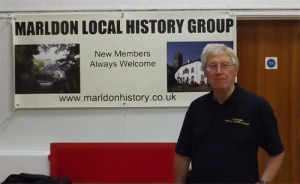This ‘potted history’ of Marldon has been written by our Group Chairman Tony Chidlow.

MARLDON is a beautiful rural parish in the South Hams of Devon comprising the village of Marldon and the hamlets of Compton and Westerland, a few miles inland from the resorts of Torbay and within easy reach of the towns of Totnes and Newton Abbot. Its topography falls from the ridge along which runs the A380 (the “ring road” which separates the parish from Torbay) and the heights of “the Beacon” down to Compton in the valley of the parish.
The parish has a population of about 3000 and is still predominately rural, having a number of working farms within its boundaries.

However, in common with many rural villages, it has had its share of postwar “bungalow” development, and its two ancient inns are now joined by three shops and a garage/petrol station. Nevertheless, it has many lanes, public footpaths and bridleways which quickly take the walker to quiet places and beautiful views. Its modern (1964) Church of England primary school, though small by today’s standards, has replaced the original school of 1865 and has an excellent record.
Marldon is probably best known today for its traditional “Apple Pie Fair”, an event having its origins in the late 19thC when George Hill, a parishioner, took his apples on his donkey cart to the weekly market at St. Marychurch, and a large apple pie to its annual fair. After his death, the Marldon Apple Pie became a feature of Marldon’s own annual show and sports day, now called Marldon Apple Pie Fair and held on the last Saturday of July each year, with a large apple pie still being carried in procession on a donkey cart.
Although Marldon is undoubtedly an ancient place, it cannot make the now ubiquitous claim of being in the Domesday Book, as “Marldon” did not exist when William’s Commissioners came to this part of Devon. However, other places now or formerly in the parish (Stantor, Occombe, Compton) do have that distinction.
Marldon’s Church of St. John the Baptist was built by the Gilbert family of Compton. The first recorded mention of a church or chapel is in 1348, and the present tower was built by William Gilbert in about 1400, whose son Otto built the church we see today, replacing the earlier building referred to in 1348.

The church is a fine building of local limestone in the late Perpendicular style, the font being contemporary with the 1450 rebuilding. The church has six bells, the oldest being contemporary with the tower and four others dating from the 16thC and 17thC. The sixth bell was added in 1970. The Church underwent a Victorian restoration in 1884 – 1889, including the removal of two galleries at the base of the tower, one for the school children and the other for the church musicians. The galleries were removed when the original organ was installed in 1885. The Church has records of its births, marriages and deaths from 1598.
The Church is at the heart of the original village, having as its immediate neighbours the Church House Inn (reputedly built for the workers building the church), the former almshouses, the former School and a cluster of white-painted cottages. The former Congregational (United Reformed) Chapel (1865) is at the top of Church Hill, oposite the former quarry from which its stone and that of the Church were quarried. Marldon’s other ancient pub, the Old Smokey House Inn, is on the old turnpike road to Brixham.
Compton Castle is the oldest building in the parish, coming into the possession of the Gilbert family in 1329. It is now recognised as one of the best examples of a fortified manor house in the country. Apart from a gap of 146 years when the estate went out of the family, the house remained with the Gilberts until it was handed to the National Trust in 1951, and is still occupied by the family.
Tony Chidlow .. Chairman

My family, the Highmore family lived in Marldon in a place named Peter’s tenement which I think was a farm. They married into another local family, the Osborne family who I am led to believe lived in Rock Cottage, Marldon. Can you please tell me more about these places?
My other link is through the Brown family who married into the Highmore family. They lived at Lovelane Farm and were milk suppliers.
The final link is with a family named Eales who ran the Church house Inn . My widowed 2x great grandmother Highmore married the landlord Mr. Eales. Her Highmore children lived there until leaving to set up their own businesses. My great grandfather was one of them, married to Mary Jane Osborne and becoming a journeyman blacksmith. We have his picture when he worked at Cockington forge.
Sorry to ramble on but I really would like to further explore my Marldon roots.
Christopher Highmore
LikeLike
Many thanks for your enquiry .. I will pass it on to Group Historian to see if they can provide some answers and get back to you in due course.
Regards
LikeLike
Hi Christopher , I can tell you great deal about the Highmores , Eales and Browns. My GG Grandfather William Brown , born 1824 ,my GGrandfather James ,born 1851, my Grandfather William ,born 1889 , and my father Geoffrey Brown , born 1926 all lived and worked in Marldon for part or all of their lives and farmed at Love Lane Farm from 1885 to 1934 ,almost 50 years. Please contact me as I am similarly completing my family tree.Regards Philip Brown Ì
LikeLike
Philip, I’ll be in touch shortly. Chris
LikeLike
Hi Chris , I think I can answer a lot of your family connections. Please contact me. Best wishes Philip Brown
LikeLike